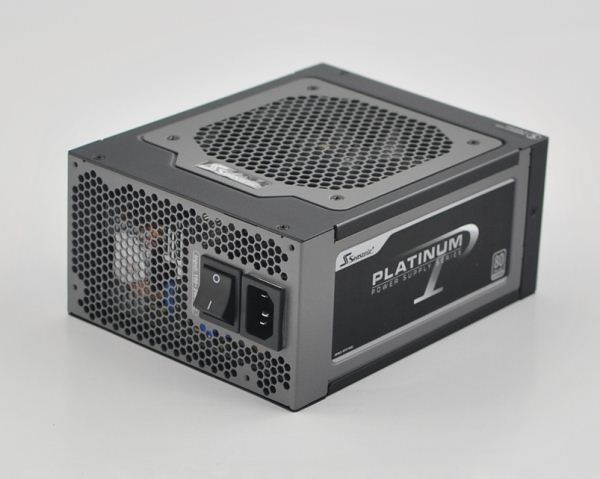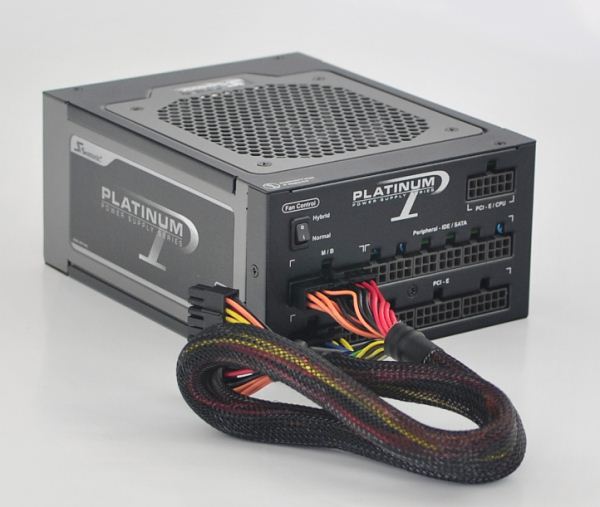Seasonic Platinum Series 860W - Platinum without the Fuss
by Martin Kaffei on February 24, 2012 12:00 AM ESTExternal Impressions, Cables, and Connectors
Other than the change in color, the top of the casing looks exactly like the one from the X-1000 and X-1250. All the sides are very thick and even after opening the chassis we couldn't find any sharp-edged parts. One side shows the name of the series, and the opposite side has the power output label. On the rear of the PSU, next to the power input is a large power switch, occupying more than its fair share of space and taking away a bit of area that would otherwise be used for the ventilation holes.
At the front we find that all the modular plugs are uniform in color. The top right socket can be used either for a PCIe or for a CPU connector. When in doubt, the customer must choose one of the two variants, but the PCIe connector can also be connected in the bottom row. Three more PCIe plugs are available, though only two of them are required for the 860W model (e.g. there are only two PCIe cable harnesses).
Worth note is that at 19cm the body is relatively long, but it's not surprisingly long for a modular PSU in this power class. The product wasn't designed for HTPCs so the length shouldn't be a point of criticism. However, you'll want to ensure your intended case has enough room for the PSU.
| Cables and Connectors | ||
|
|
Main | 1x 24-pin (60cm) modular |
| ATX12V/EPS12V |
4+4-pin (65cm) 8-pin (65cm) all modular |
|
| PCIe |
2x 6/8-pin (60cm) 2x 6/8-pin (60cm) all modular |
|
| Peripheral |
3x SATA (55, 70, 85cm) 3x SATA (55, 70, 85cm) 3x SATA (55, 70, 85cm) 2x SATA (35, 50cm) all modular |
|
|
3x Molex (55, 70, 85cm) 3x Molex (55, 70, 85cm) 2x Molex (35, 50cm) all modular |
||
In total there are eleven SATA connectors on four separate harnesses, which is above average. The eight Molex connectors are common for this performance category. Note that the connector panel of the PSU only supports using six total harnesses, so you'll have to either skip out on one SATA harness or one of the Molex harnesses. Apart from the two slightly shorter peripheral cables it would have been nice to get different lengths for the remaining SATA and Molex cables.
As noted above the upper socket can be used for graphics cards or the CPU. At up to 85cm long, the peripheral cables should work in nearly all cases, while the mainboard and PCIe plugs reach 60-65cm. The 24-pin plug is connected to the bottom row (with 12 volt) and the middle row as well.
The cable sleeving is very good and relatively opaque, but ends just before the plug sockets, which doesn't look as good as it could. That's apparently the price one must pay for the full modular connector system; perhaps flat cables would be a better solution here. But this is a matter of taste. As always the electronics is much more important for us.


















69 Comments
View All Comments
kmmatney - Friday, February 24, 2012 - link
Yup. I'd really like one of these, but find it hard to justify the big price jump to get to platinum efficiency. You can get all the PSU you need (Corsair GS800) for $115. It is nice, though. I'm still running a Corsair TX650 which I bought 5 years ago for $90 or so.Hrel - Friday, February 24, 2012 - link
Most seasonics have NO noise under about half load. Why is this one noisy? Also what's with the "electrical noise". I don't wanna hear a damn thing. "Best power supply ever", psh, not if I can hear it.palindrome - Friday, February 24, 2012 - link
Martin,It is hard to take much stock from your review. Especially when you write a garbage conclusion that claims Super Flower products a bad product because of their name. The last Super Flower manufactured PSU reviewed on Anandtech was 10/16/2008 by Christoph Katzer. Also, your testing equipment and methodology is not listed in this article. For all we, as readers, know, you could be using a kill-a-watt and a RadioShack multimeter. You should also list your error tolerance for your readings, no matter what equipment you are using. When I read this article, I thought I might have mistakenly been redirected to Tom's for a moment.
I'm sure reviewers such as yourself all have opinions and incentives to write nice reviews for the generous companies who give you free, expensive toys to play with. However, you should let your test results do the talking and provide some of the basic information, such as methodology, just like we all learned in 5th grade science class, so that you can be much more credible. This isn't the worst PSU review I've seen from a major tech site (Tom's has that locked down tight), but I certainly expect more from Anandtech.
Time to get flamed by the herd.
smilingcrow - Friday, February 24, 2012 - link
We’re not worthy.I have the 400W Gold fanless version and we’ve set a date for the autumn.
Crypticone - Friday, February 24, 2012 - link
I would really like to see some real world usage testing. Clearly every uses computers in a different manner and I am not sure the best way to go about it.Much like you have a very standardized testing bed for computer cases. It would be nice to have some measure of power usage over a certain period of time.
Using the same computer setup run the system for two hours at idle speed measuring power usage. Then two hours looping some gaming type benchmark. Then two hours of scripted web browsing. Then an hour fully loading the CPU with prime. Then maybe two hours of streaming media to a media player of some sort.
Then it would be nice to see how much power is saved between the units. It would be interesting to see where the mock breakeven point is power savings vs the added cost of these new pricey power supplies vs a gold or silver rated PSU.
This might be more of a feature article then something done for every PSU you review.
John Doe - Friday, February 24, 2012 - link
That SuperFlower you just threw off in a whim makes a unit that outdoes the Platinum 1000; the LZP-1000.http://enthusiast.hardocp.com/article/2012/01/04/k...
It gets about 30mV ripple against the 60's of the SeaSonic, has quicker transient turn-on response and sells for $70 cheaper.
One of the main goals of a review is to be subjective, which is what this review is not. This is a load of garbage.
smilingcrow - Saturday, February 25, 2012 - link
From the review you linked to:“If you want the absolute best power supply we have seen then you still want the Seasonic Platinum-1000.”
And you want a review to be objective not subjective!
Martin Kaffei - Saturday, February 25, 2012 - link
John,I got an XFX PSU which is exactly like the 1KW version from Seasonic and I never saw more than 30 mV as well.
Does HardOCP measure with capacitors conformable to ATX specification? You need them to simulate system load, otherwise the results do not apply to a real PC.
Hereunder Seasonic might be worse than SuperFlower, but your PC doesn't get the pure ripple. With ATX test environments Seasonic is always as good as or even better than SuperFlower.
John Doe - Saturday, February 25, 2012 - link
What're you on about? Yes, Paul puts all the units in an incubutor for at least 8 hours. And you? Have you even explained your test methodology? You aren't making any sense and aren't fooling anybody with little SMPS knowledge.If you look at Oklahoma Wolf's results, you can find the same. The Golden King 1000 (which you labeled as a joke just because of it's name) usually has lower ripple, better transient response, better cooling and sells for cheaper. The only thing the SeaSonic has over it is better regulation.
It's clear that either you're unknowledgeable or you have a personal agenda, with the latter making more sense. Excuse my bluntness, but you're diviving into pure nonsense.
DanNeely - Saturday, February 25, 2012 - link
You've got 28 pins on the PSU for a 24pin cable.